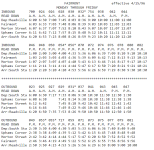Why does the MBTA advertise the Track Improvement Program as "reducing travel times", when it is just "restoring normal speed travel times"?
I feel like it is just restoring the travel times that ran near/essentially-full speed pre-FTA inspections in spring 2022 (sans Orange Line in downtown that had it's slow zone near South Cove for ages). It's not like its going to increase the design speed of the tracks from 40 MPH (64 KMH) to 50 MPH (80 KMH). It's just lifting slow orders that prevents full speed operation, so it's restoring travel times, not reducing travel times. If Track Improvement Program were to raise the operating design speed of the tracks and trains from pre-pandemic 40 MPH (64 KMH) to a brand new higher 55 MPH (88 KMH), that would be "reducing travel times".
If it was going to reduce travel times, than I would expect travel times to be faster than any point pre-COVID (which seems possible for Orange, but I highly doubt Blue or Red will be faster than pre-COVID, but it would likely be the same as pre-COVID).
If it just restores the speeds from pre-pandemic than the TIP program should just be called "restoring tracks and restoring travel times".
In addition, 6 weeks after the great Green Line shutdowns, the Green Line remains noticably slower than it was in the 2 months in early 2023 prior to the systemwide slow order, despite fewer slow zones today than January/February 2023. The Green Line isn't seeing reduced travel times (the fastest the Green Line ran prior to COVID-19 was in Spring 2018), and the
T's Track Improvement slides from April 25 notes only 4 minutes (of the promised 28 minutes) were given back to riders on the Green Line after removing 95% of the Green Line's slow zones. If the Green Line is going to see "reduced travel times", then it should be as fast as May 2018. (There were spikes for the OL shutdown and Marathon Monday, but even when removing those spikes, speeds on the Green Line are still slower than even Spring-Summer 2023 after the systemwide slow orders were given. (Kenmore - Haymarket EB,
Source: TransitMatters data dashboard)
What we saw:
What we expected from Track Improvement Program:


